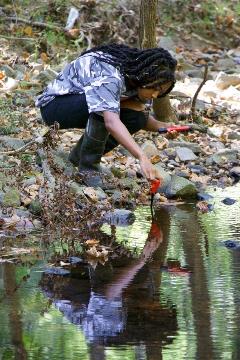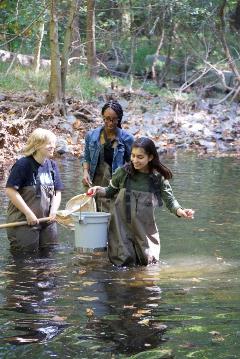Rebecca Shoer, Save Our Streams Coordinator
We all need natural spaces. Whether it’s kayaking down a river, hiking through woods, or simply enjoying clean air and water, healthy ecosystems enrich our lives in countless ways. Conserving natural spaces by establishing parks and reserves is a great way to protect wildlife – but sometimes, habitats have become so damaged and degraded that they must be restored before they can be protected. Restoration is still a changing and developing field, but the philosophy behind it remains the same: how can we restore a degraded habitat to one that is a functioning and healthy ecosystem? Most importantly, how can we tell if a restoration project worked?
Monitoring stream health is a critical piece of any restoration project – it’s how we know whether the restoration was successful.
A few weeks ago, I joined Save Our Streams monitors and staff from the Reston Association, Wetlands Studies and Solutions Inc., Fairfax Water, and the United States Geological Survey (USGS) for a restoration monitoring day. Our target was Snakeden Branch, a stream in Reston, Virginia.
Before these groups launched a massive restoration effort, Snakeden was in bad shape: severe erosion had carved out banks up to ten feet high, and exposed sewer lines were clearly visible from shore. But the bigger problem was the quality of the water in the stream. Snakeden Branch eventually joins Little Difficult Run and the Potomac River, from which many people in the DC metro area get their drinking water. Polluted runoff from yards, parking lots, and roads was flowing straight into Snakeden Branch and could have been directly affecting communities just downstream.
Snakeden Branch before and after restoration.
The restoration efforts, which began in 2007, included raising the streambed, planting vegetation along the banks, and creating the kinds of riffles and pools that occur in natural and healthy streams. As the restoration project began winding down in 2009, Marty Gurtz and Mike Meador from USGS approached the groups working on the project to see if they could launch a monitoring program with students from the nearby South Lakes High School biology program. Monitoring stream health is a critical piece of any restoration project – it’s how we know whether the restoration was successful.

Fast forward to 2019, and South Lakes’ biology students were back in the field for the 11th annual monitoring day at Snakeden Branch. Although some first-timers in the group were initially hesitant about pulling on chest waders and climbing into the stream, within a few minutes all were eagerly sampling the streambed and peering into nets and buckets. While I worked with one team to gather macroinvertebrates, other teams tested for water quality, performed a habitat assessment, and evaluated stream flow.
Of course, the students weren’t only learning how to gather data. Many students had been surprised to discover, the first time they made the ten-minute walk from their classroom to their study site, that Snakeden Branch flows so close to their school – and many hadn’t known that the little stream is directly connected to their drinking water. The students also learned how to recognize signs that the healthy-looking stream had been damaged and then restored. Although this may sound like difficult material to master, the students found they were up to the challenge. “They know more than they think they know,” said Mike Meador.

So how is Snakeden Branch doing? Until the new data is analyzed, we can’t say if the restoration was successful or not. But the South Lakes students experienced an invaluable opportunity to practice monitoring techniques used by natural resource professionals every day. They also know that their data is incredibly valuable.
“Without annual monitoring,” said William Peterson, Reston Association’s Watershed Manager, “we would have no idea of how a stream changes over time following a restoration. The data collected by these students is showing how macroinvertebrates have reestablished in the stream.”
Once analyzed, the students’ data will be used by scientists with the Reston Association and Wetlands Studies and Solutions Inc. to develop a long-term management plan for Snakeden Branch. By working together, students, scientists, and other conservation partners will transform this once-struggling stream back into a healthy ecosystem that enriches the lives of people and wildlife.
Photos of students courtesy of Bill Ferzoco. Stream photos courtesy of Northern Virginia Stream Restoration Bank.